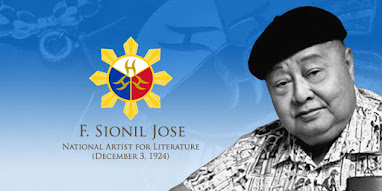Alejandro Roces, is a short story writer and essayist and considered as the country’s best writer of comic short stories. He is known for his widely anthologized “My Brother’s Peculiar Chicken.” In his innumerable newspaper columns, he has always focused on the neglected aspects of the Filipino cultural heritage. His works have been published in various international magazines and have received national and international awards.
Ever the champion of Filipino culture, Roces brought to public attention to the aesthetics of the country’s fiestas. He was instrumental in popularizing several local fiestas, notably, Moriones and Ati-atihan. He personally led the campaign to change the country’s Independence Day from July 4 to June 12, and caused the change of language from English to Filipino in the country’s stamps, currency, and passports, and recovered Jose Rizal’s manuscripts when they were stolen from the National Archives.
His unflinching love of country led him to become a guerilla during the Second World War, to defy martial law and to found the major opposition party under the dictatorship. His works have been published in various international magazines and received numerous national and international awards, including several decorations from various governments.
ROLANDO S. TINIO
March 5, 1937 – July 7, 1997
Year of Conferment: 1997
Rolando S. Tinio, playwright, thespian, poet, teacher, critic, and translator marked his career with prolific artistic productions. Tinio’s chief distinction is as a stage director whose original insights into the scripts he handled brought forth productions notable for their visual impact and intellectual cogency.
Subsequently, after staging productions for the Ateneo Experimental Theater (its organizer and administrator as well), he took on Teatro Pilipino. It was to Teatro Pilipino which he left a considerable amount of work reviving traditional Filipino drama by re-staging old theater forms like the sarswela and opening a treasure-house of contemporary Western drama. It was the excellence and beauty of his practice that claimed for theater a place among the arts in the Philippines in the 1960s.
Aside from his collections of poetry (Sitsit sa Kuliglig, Dunung – Dunungan, Kristal na Uniberso, A Trick of Mirrors) among his works were the following: film scripts for Now and Forever, Gamitin Mo Ako, Bayad Puri and Milagros; sarswelas Ang Mestisa, Ako, Ang Kiri, Ana Maria; the komedya Orosman at Zafira; and Larawan, the musical.
LEVI CELERIO
April 30, 1910 – April 2, 2002
Year of Conferment: 1997
Levi Celerio is a prolific lyricist and composer for decades. He effortlessly translated/wrote anew the lyrics to traditional melodies: “O Maliwanag Na Buwan” (Iloko), “Ako ay May Singsing” (Pampango), “Alibangbang” (Visaya) among others.
Born in Tondo, Celerio received his scholarship at the Academy of Music in Manila that made it possible for him to join the Manila Symphony Orchestra, becoming its youngest member. He made it to the Guinness Book of World Records as the only person able to make music using just a leaf.
A great number of his songs have been written for the local movies, which earned for him the Lifetime Achievement Award from the Film Academy of the Philippines. Levi Celerio, more importantly, has enriched the Philippine music for no less than two generations with a treasury of more than 4,000 songs in an idiom that has proven to appeal to all social classes.
RESIL B. MOJARES
September 4,1943 - PRESENT
Year of Conferment: 2018
A teacher and scholar, essayist and fictionist, and cultural and literary historian, Resil Mojares is acknowledged as a leading figure in the promotion of regional literature and history. As founding director of the Cebuano Studies Center—an important research institution which placed Cebu in the research and documentation map—he pioneered Cebuano and national identity formation.
As a leading figure in cultural and literary history, he networked actively in many organizations. For over 50 years, Mojares has published in diverse forms (fiction, essay, journalism, scholarly articles, and books) across a wide range of discipline (literature, history, biography, cultural studies, and others). To date, he has 17 published books (3 more in the press) and edited, co-edited, or co-authored 11 books, and written numerous articles for popular and scholarly publications.
His notable works are - Origins and Rise of the Filipino Novel: A Generic Study of the Novel Until 1940
(Quezon City, UP Press, 1983; second ed. 1998) - The Man Who Would Be President: Serging Osmeña and Philippine Politics
(Cebu: Maria Cacao, 1986) - Waiting for Mariang Makiling: Essays on Philippine Cultural History
(Quezon City: Ateneo de Manila University Press, 2002) - Theater in Society, Society in Theater: Social History of a Cebuano Village, 1840-1940 (Quezon City: Ateneo de Manila University Press, 1985)
- The War Against the Americans: Resistance and Collaboration in Cebu, 1899-1906 (Quezon City: Ateneo de Manila University Press, 1999)
- House of Memory: Essays (Metro Manila: Anvil Publishing, 1997)
- Brains of the Nation: Pedro Paterno, T.H. Pardo de Tavera, Isabelo de los Reyes and the Production of Modern Knowledge
(Quezon City: Ateneo de Manila University Press, 2006) - Isabelo’s Archive (Metro Manila: Anvil Publishing, 2013).
RAMON L. MUZONES
March 20, 1913 - August 17, 1992
Year of Conferment: 2018
Ramon Muzones was a Hiligaynon poet, essayist, short story writer, critic, grammarian, editor, lexicographer, and novelist who authored an unprecedented 61 completed novels. A number of these represent groundbreaking “firsts’ in Hiligaynon literature such as the feminist Ang Bag-ong Maria Clara, the roman a clef Maambong Nga Sapat (Magnificent Brute,1940), the comic Si Tamblot (1946), the politically satirical Si Tamblot Kandidato Man (Tamblot is Also a Candidate, 1949), the 125- installment longest serialized novel Dama de Noche (1982-84), etc.
Hailed by his peers as the longest reigning (1938-1972) among “the three kings of the Hiligaynon novel,” Muzones brought about its most radical changes while ushering in modernism. With a literary career that spanned fifty-three years (1938-1990), his evolution covers the whole history of the Hiligaynon novel from its rise in the 1940s to its decline in the 1970s.
Muzones tried his hand at a variety of types and proved adept in all as literary fashions. In the process, he not only extended with remarkable versatility and inventiveness the scope and style of the Hiligaynon novel, but he also enriched Hiligaynon literature’s dramatis personae.
His notable works are:
- Shri-Bishaya (1969)
- Malala nga Gutom (Malignant Hunger,1965)
- Babae Batuk sa Kalibutan (Woman Against the World,1959)
- Ang Gugma sang Gugma Bayaran (Love with Love Be Paid, 1955)
- Si Tamblot (1948)
- Margosatubig (1946)
Reference:
Order of National Artists: Lazaro Francisco. (n.d.). Retrieved September 30, 2020, from https://ncca.gov.ph/about-culture-and-arts/culture-profile/national-artists-of-the-philippines/lazaro-francisco/









Comments
Post a Comment